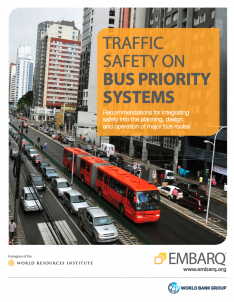Traffic Safety on Bus Priority Systems
This report includes recommendations for integrating safety into the planning, design, and operation of major bus routes.

Bus rapid transit (BRT) and bus priority systems have become an attractive solution to urban mobility needs in recent years because of their relatively low capital costs and short construction times compared to rail transit.
As these systems gain popularity,1 a number of studies and planning guides have appeared, illustrating the different design options available and their impact on the operational performance of the systems, as well as outlining some of the institutional challenges to implementation (see Rickert 2007; Hidalgo and Carrigan 2010; and Moreno González, Romana, and Alvaro 2013).
The traffic safety aspects of bus priority systems, however, are typically not as well understood as the better documented impacts on travel times, greenhouse gas and local pollutant emissions, or land values. Our research shows that bus priority systems have had significant positive impacts on traffic safety, reducing severe and fatal crashes on the streets where they were implemented by over 50% (Duduta, Lindau, and Adriazola-Steil 2013). From this, we estimate that safety impacts typically account for 8% to 16% of the total economic benefits on these types of systems.
This report is based on an extensive research project on the traffic safety aspects of bus priority systems, based on data analysis, road safety audits and inspections on over thirty bus systems around the world, and microsimulation models testing the impact of safety countermeasures on operational performance.
This report is designed as a practical guide for transportation planners, engineers, and urban designers involved in the planning and design of bus systems. It covers a broad spectrum of system and corridor types, ranging from curbside bus priority lanes to high-capacity, multi-lane, and median-running BRTs. We identify the main risk factors and common crash situations, and suggest design concepts to address them. We also consider how the main design concepts impact the operational performance of the bus system, with a focus on passenger capacity, travel times, and fleet size requirements.